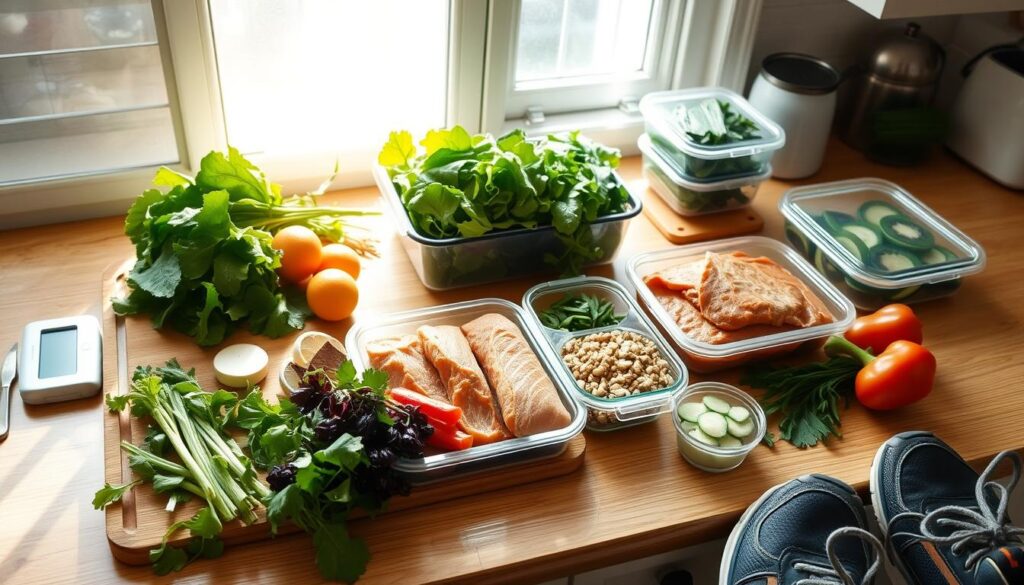The Top 10 Foods that Can Help You Lose Weight
Building a healthier lifestyle starts with smart dietary choices. While no single food guarantees weight loss, certain options can boost metabolism, curb cravings, and support overall wellness. Research highlights nutrient-dense picks like chia seeds for fiber, fatty fish for omega-3s, and cruciferous vegetables for antioxidants.
This guide explores ingredients backed by science and USDA guidelines. Focus falls on items rich in protein, healthy fats, and complex carbs. These elements promote satiety while fueling physical activity and bodily functions.
Practical meal ideas will show how to integrate these foods into daily routines. For example, swapping refined grains for quinoa or adding avocado to salads enhances nutritional value without sacrificing flavor. Small changes create lasting habits.
A balanced approach remains essential. Pairing smart food selections with portion control and regular exercise yields better results than extreme restrictions. Sustainable weight management prioritizes both physical health and mental well-being.
Key Takeaways
- Nutrient density matters more than calorie counting alone
- Fiber-rich foods like chia seeds aid digestion and fullness
- Omega-3s from fish support metabolic health
- Meal planning prevents impulsive eating decisions
- Long-term success requires consistency over quick fixes
Introduction to Foods for Effective Weight Loss
Fueling your body with the right nutrients lays the groundwork for sustainable weight management. Research shows that focusing on high-fiber foods, lean proteins, and unsaturated fats creates a metabolic environment primed for fat burning. These components work together to stabilize blood sugar, reduce cravings, and optimize energy levels.
Nutrient Synergy Matters
Fiber-rich options like chia seeds and broccoli slow digestion, keeping hunger signals at bay. A 2022 study found that increasing daily fiber intake by 14 grams led to a 10% reduction in calorie consumption. Protein sources like eggs and legumes take longer to break down, while healthy fats from avocados or nuts trigger satiety hormones.
“Diets combining 25-30 grams of fiber with adequate protein intake demonstrate 23% higher long-term success rates,” notes a USDA analysis of weight management trials.
Building Balance Into Every Meal
Effective strategies prioritize nutrient density over strict calorie counting. For example:
| Nutrient | Role | Daily Target |
|---|---|---|
| Fiber | Slows digestion | 25-38g |
| Protein | Preserves muscle | 0.8g/kg body weight |
| Healthy Fats | Regulates hormones | 20-35% of calories |
Upcoming sections will explore how specific foods deliver these nutrients in practical combinations. Learn to create meals that satisfy taste buds while supporting your goals.
The Importance of Fiber, Protein, and Healthy Fats
Mastering meal composition plays a pivotal role in managing hunger and energy levels. Three nutritional powerhouses work together to optimize metabolism while keeping cravings in check.
How Fiber Keeps You Full Longer
Soluble fiber absorbs water to form a gel-like substance in the gut. This slows digestion, delaying stomach emptying by up to 40% according to a 2023 Nutrition Journal study. Chia seeds shine here – just two tablespoons provide 10 grams of fiber, nearly half the daily recommendation.
Hunger hormones like ghrelin decrease as fiber-rich meals stretch intestinal walls. “Foods with 5+ grams of fiber per serving reduce between-meal snacking by 32%,” states registered dietitian Dr. Ellen Pratt. Pair high-fiber choices like lentils or oats with water for maximum effect.
The Synergy of Protein and Healthy Fats
While fiber manages digestion speed, protein repairs tissues and maintains lean muscle mass. Eggs deliver 6 grams of premium protein per serving, helping preserve metabolism during calorie deficits. When combined with fats like avocado, meals trigger the release of peptide YY – a hormone that signals fullness for hours.
Research in Cell Metabolism reveals meals blending 20g protein with monounsaturated fats extend satiety 45% longer than low-fat alternatives.
Try this combo: grilled salmon (rich in omega-3s) with steamed broccoli. The fish provides protein and anti-inflammatory fats, while the veg adds crunch and fiber. For breakfast, whip up chia pudding topped with almond butter and blueberries – a trifecta of nutrients that stabilizes energy until lunch.
the top 10 foods that can help you lose weight: A Closer Look
Understanding how specific ingredients influence metabolism offers a roadmap for sustainable weight management. Let’s examine key options backed by clinical evidence and culinary flexibility.
Highlights of Each Top Food Choice
Chia seeds deliver 11 grams of fiber per ounce – meeting 44% of USDA daily targets. Studies show their soluble fiber expands in liquid, creating a fullness effect lasting 4-6 hours. Pair with yogurt or blend into smoothies.
Wild-caught salmon provides 1,500mg omega-3s per 3oz serving. Research in Obesity Reviews links these fatty acids to 23% faster metabolic rates during rest. Try glazing fillets with miso-maple marinades for flavor without excess calories.
Roasted broccoli unlocks sulforaphane, a compound shown to reduce fat storage hormones. One cup contains 2.4g fiber and 135% daily vitamin C needs. Almonds offer similar benefits – a 2021 trial found 1.5oz daily decreased waist circumference by 1.2 inches over 12 weeks.
Scientific Research and Dietary Guidelines
Beans and lentils exemplify nutrient synergy. A Journal of Nutrition study revealed adults consuming ¾ cup daily lost 25% more weight than control groups. Their resistant starch feeds gut bacteria linked to appetite regulation.
“Whole grains like quinoa and oats slow glucose absorption, preventing energy crashes that trigger overeating,” states NIH dietary guidelines.
Homemade trail mix combines seeds, nuts, and dark chocolate for balanced snacking. Walnuts’ ALA content reduces inflammation, while pumpkin seeds add magnesium to support muscle function during workouts. Aim for ¼-cup portions to manage calories.
Navigating Serving Sizes and Meal Planning
Smart portion management transforms quality ingredients into tangible results. Balancing nutrient intake while controlling calories requires practical measurement strategies and intentional meal design.

Portion Control Strategies
Use simple tools to avoid overeating. A ¼-cup measures nuts perfectly – about 160 calories of almonds provides healthy fats without excess. For proteins like grilled chicken, aim for palm-sized portions (3-4 oz). Visual cues work too: a fist equals 1 cup of grains or chopped veggies.
| Food Group | Serving Size | Visual Guide |
|---|---|---|
| Nuts/Seeds | ¼ cup | Cupped hand |
| Cooked Grains | ½ cup | Tennis ball |
| Lean Protein | 3 oz | Deck of cards |
Creative Meal Ideas Incorporating These Foods
Start mornings with chia pudding: mix 2 tablespoons seeds with almond milk and berries. Lunch could be salmon salad – 4 oz fish over mixed greens with olive oil dressing. For dinner, stir-fry broccoli and tofu with quinoa.
Snack smartly between meals:
- Apple slices with almond butter (1 tbsp)
- Hard-boiled egg + carrot sticks
- ¼ cup trail mix (walnuts, pumpkin seeds, dark chocolate)
Hydration supports energy balance. Drink water before meals – studies show this reduces calorie intake by 13%. Add lemon or mint for flavor without added sugars.
Spotlight on Nutrient-Rich Options Backed by Research
Science continues to uncover connections between nutrient-rich diets and sustainable weight outcomes. Emerging studies highlight how specific vitamins, proteins, and fatty acids optimize metabolic processes while reducing inflammation.
Insights from Recent Studies and Dietary Experts
Legumes like black beans deliver 15g protein and 40% daily folate needs per cup. A 2023 Nutrition & Metabolism review found adults eating ½ cup legumes daily lost 14% more belly fat than control groups. Their high fiber content stabilizes blood sugar, curbing cravings.
Low-fat cottage cheese provides 28g protein per cup with minimal sugar. Research shows its casein protein suppresses hunger hormones for up to 8 hours. Eggs offer similar benefits – their amino acids boost muscle repair by 33% post-workout according to sports nutritionists.
“Omega-3 fatty acids in walnuts and flaxseeds reduce inflammatory markers linked to weight retention,” states a Journal of the American Heart Association meta-analysis of 17 trials.
| Food | Protein (per serving) | Key Nutrients | Research Findings |
|---|---|---|---|
| Cottage Cheese | 28g | Calcium, B12 | Reduces late-night snacking by 40% |
| Eggs | 6g | Choline, Selenium | Enhances satiety for 3+ hours |
| Black Beans | 15g | Fiber, Iron | Lowers insulin spikes by 22% |
Balancing macros matters. The 2020-2025 Dietary Guidelines emphasize replacing refined sugars with complex carbs and healthy fats. This approach supports cellular energy production while preventing fat storage triggers.
Integrating These Foods Into Your Daily Routine
Practical meal ideas turn nutritional science into everyday habits. Start with simple swaps that pack flavor and staying power without complicated prep work.

Simple Recipe Ideas for Breakfast, Lunch, and Dinner
Kickstart mornings with a berry-mint kefir smoothie: blend 1 cup plain kefir, ½ frozen banana, and a handful of spinach. Add chia seeds for extra fiber – they’ll thicken the mix while you finish getting ready. For savory options, try scrambled eggs with diced peppers and a sprinkle of pumpkin seeds.
Lunch becomes effortless with mason jar salads. Layer quinoa, chickpeas, and roasted veggies in a portable container. Top with olive oil dressing and walnuts for crunch. Research shows meal prepping reduces impulsive choices by 67%, according to insulin response management studies.
Dinner shines with stuffed avocados. Halve the fruit, fill with black beans and salsa, then bake at 375°F for 12 minutes. Pair with steamed broccoli for a balanced plate. Snack smart between meals – keep portioned almonds or apple slices with almond butter nearby.
“Consistency beats perfection. Three balanced meals with planned snacks create metabolic rhythm,” advises nutritionist Marco Reyes in Today’s Dietitian.
Whole grains like oats or brown rice anchor meals while slowing digestion. Try overnight oats with almond milk for breakfast or stir-fry cauliflower rice for dinner. These small shifts build lasting patterns without drastic lifestyle changes.
Lifestyle Habits That Boost Metabolism and Support Weight Loss
Optimizing daily habits extends beyond the kitchen for lasting metabolic benefits. While nutrient-dense meals form a foundation, physical activity and hydration patterns significantly influence how efficiently your body burns calories. Research shows combining these elements creates a 30% greater energy deficit compared to dietary changes alone.
Movement Matters
Strength training builds lean muscle mass, which burns 50% more calories at rest than fat tissue. Just two weekly resistance sessions increase resting metabolic rate by 5%, according to a 2023 Journal of Applied Physiology study. Pair this with 150 minutes of weekly cardio – brisk walks count – to amplify results.
Hydration accelerates these effects. Drinking 17oz of water boosts metabolic rate by 30% for 40 minutes, per The Journal of Clinical Endocrinology & Metabolism. Carry a reusable bottle and sip throughout the day, especially before meals.
| Activity | Duration | Metabolic Boost |
|---|---|---|
| Strength Training | 30 mins | +9% for 15 hours |
| HIIT Workouts | 20 mins | +25% post-exercise |
| Walking | 45 mins | +19% fat oxidation |
Time-crunched? Break workouts into 10-minute bursts. Take stairs instead of elevators, or do bodyweight exercises during TV ads. These micro-sessions cumulatively burn 350+ weekly calories.
For sustainable weight management, pair these strategies with balanced nutrition plans. Consistency trumps intensity – small daily efforts compound into lasting metabolic advantages.
Conclusion
Sustainable weight management thrives on combining nutrient-rich choices with mindful habits. Chia seeds, salmon, and broccoli deliver fiber, omega-3s, and antioxidants that support metabolism. No single ingredient guarantees loss, but balanced plates blending proteins, fats, and complex carbs create lasting results.
Portion control remains critical – use palm-sized proteins and cupped handfuls of nuts. Hydration amplifies these efforts: drinking water before meals reduces overeating risks. Pair dietary changes with strength training or brisk walks to boost calorie burn by 30%.
Experiment with meal prep strategies like overnight oats or mason jar salads. These practical swaps build routines without drastic overhauls. Remember, gradual progress beats extreme restrictions – losing 1-2 pounds weekly proves more sustainable than rapid drops.
Trust the process. Small, consistent changes – adding seeds to smoothies or choosing grilled fish over fried options – compound into transformative outcomes. Your journey toward healthier weight begins with today’s choices.






